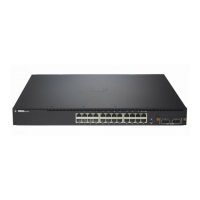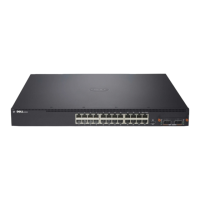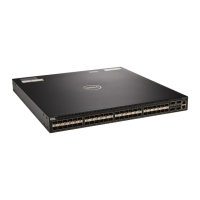Starting and Configuring the Switch 21
Connecting a Switch to a Terminal
After completing all external connections, connect a terminal to a switch to
configure the switch.
NOTE: Read the release notes for this product before proceeding. You can
download the release notes from the Dell Support website at
dell.com/support.
NOTE: We recommend that you obtain the most recent version of the user
documentation from the Dell Support website at
dell.com/support.
To monitor and configure the switch via serial console, use the RJ45 console
port on the back panel of the switch to connect it to a VT100 terminal or to a
computer running VT100 terminal emulation software. The console port is
implemented as a data terminal equipment (DTE) connector.
The following equipment is required to use the console port:
• VT100-compatible terminal or a desktop or a portable computer with a
serial port running VT100 terminal emulation software,
such as
Microsoft
®
HyperTerminal.
• A serial cable (provided) with a RJ45 connector for the console port and
DB-9 connector for the terminal.
Perform the following tasks to connect a terminal to the switch console port:
1
Connect the DB-9 connector on the serial cable to the terminal or
computer running VT100 terminal emulation software.
2
Configure the terminal emulation software as follows:
a
Select the appropriate serial port (for example, COM 1) to connect to
the console.
b
Set the data rate to 9600 baud.
c
Set the data format to 8 data bits, 1 stop bit, and no parity.
d
Set the flow control to none.
e
Set the terminal emulation mode to
VT100
.
f
Select Terminal keys for Function, Arrow, and Ctrl keys. Ensure that
the setting is for Terminal keys (not Microsoft Windows
®
keys).
3
Connect the RJ45 connector on the cable directly to the Dell Networking
N4000 RJ45 console port located on the back of the switch.

